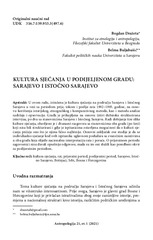Приказ основних података о документу
Kultura sjećanja u podijeljenom gradu: Sarajevo i Istočno Sarajevo
Cultural memory in the divided city: Sarajevo and East Sarajevo
| dc.creator | Dražeta, Bogdan | |
| dc.creator | Buljubašić, Belma | |
| dc.date.accessioned | 2023-11-23T17:38:26Z | |
| dc.date.available | 2023-11-23T17:38:26Z | |
| dc.date.issued | 2021 | |
| dc.identifier.issn | 1452-7243 | |
| dc.identifier.uri | https://www.antropologija.com/index.php/an/article/view/17 | |
| dc.identifier.uri | http://reff.f.bg.ac.rs/handle/123456789/5393 | |
| dc.description.abstract | U ovom radu, istražena je kultura sjećanja na području Sarajeva i Istočnog Sarajeva u vezi sa periodom prije, tokom i poslije rata 1992–1995. godine, na osnovu korištenja istorijskog, etnografskog i komparativnog metoda, kao i metoda analize sadržaja i opservacije. Građa je prikupljena na osnovu četiri dubinska strukturirana intervjua, po dva sa stanovnicima Sarajeva i Istočnog Sarajeva. Radi dobijanja šire slike kulturе sjećanja, obavljeno je i dvanaest razgovora sa stanovnicima oba grada (po šest) koji nisu bili strukturirani i gdje je ispitanicima ostavljena mogućnost da o kulturi sjećanja pričaju ono što je njima lično najbitnije. Osnovni zaključak ove studije je da se individualno sjećanje kod svih ispitanika uglavnom podudara sa zvaničnim narativima u oba grada koja slijede nacionalnu interpretaciju rata i poraća. O prijeratnom periodu sagovornici nisu davali opsežnije odgovore, mada su im oni služili kao poredbeni okvir sa poslijeratnim periodom. | sr |
| dc.description.abstract | In this paper the culture of memory was explored in the area of Sarajevo and East Sarajevo in relation to the period before, during and after the war (1992–1995). Historical, ethnographic and comparative methods were used, as well as the method of content analysis and observation. The material was collected on the basis of four in-depth structured interviews, two each with residents of Sarajevo and East Sarajevo. In order to get a broader picture of the culture of memory, 12 interviews were conducted with residents of both cities (six each). These interviews were not structured and respondents were given the opportunity to talk what was most important to them personally regarding the culture of memory. The main conclusion of this study is that the individual memory of all interlocutors mostly coincides with the official narratives in both cities that follow the national interpretation of the war period and the postwar period. The respondents did not give more extensive answers about the pre-war period, although they served as a comparative framework with the post-war age. | sr |
| dc.language.iso | sr | sr |
| dc.publisher | Институт за етнологију и антропологију Филозофског факултета у Београду | sr |
| dc.rights | openAccess | sr |
| dc.rights.uri | https://creativecommons.org/licenses/by/4.0/ | |
| dc.source | Antropologija: časopis Centra za etnološka i antropološka istraživanja (CEAI) Filozofskog fakulteta Univerziteta u Beogradu | sr |
| dc.subject | kultura sjećanja | sr |
| dc.subject | rat | sr |
| dc.subject | prijeratni period | sr |
| dc.subject | poslijeratni period | sr |
| dc.subject | Sarajevo | sr |
| dc.subject | Istočno Sarajevo | sr |
| dc.subject | Bošnjaci | sr |
| dc.subject | Srbi | sr |
| dc.subject | Bosna i Hercegovina | sr |
| dc.subject | culture of memory | sr |
| dc.subject | war | sr |
| dc.subject | pre-war period | sr |
| dc.subject | post-war period | sr |
| dc.subject | Sarajevo | sr |
| dc.subject | East Sarajevo | sr |
| dc.subject | Bosniaks | sr |
| dc.subject | Serbs | sr |
| dc.subject | Bosnia and Herzegovina | sr |
| dc.title | Kultura sjećanja u podijeljenom gradu: Sarajevo i Istočno Sarajevo | sr |
| dc.title | Cultural memory in the divided city: Sarajevo and East Sarajevo | sr |
| dc.type | article | sr |
| dc.rights.license | BY | sr |
| dc.citation.epage | 130 | |
| dc.citation.issue | 1 | |
| dc.citation.spage | 113 | |
| dc.citation.volume | 21 | |
| dc.identifier.fulltext | http://reff.f.bg.ac.rs/bitstream/id/13354/bitstream_13354.pdf | |
| dc.identifier.rcub | https://hdl.handle.net/21.15107/rcub_reff_5393 | |
| dc.type.version | publishedVersion | sr |
| dc.identifier.cobiss | 56162569 |

